This article needs additional citations for verification .(August 2021) |
The Purvanchal Range, or Eastern Mountains, is a sub-mountain range of the Himalayas in northeast India. It lies south of the Brahmaputra valley.
This article needs additional citations for verification .(August 2021) |
The Purvanchal Range, or Eastern Mountains, is a sub-mountain range of the Himalayas in northeast India. It lies south of the Brahmaputra valley.
The Purvanchal Range or Eastern Mountains are a sub-mountain range of Himalaya, covering an area of about 94,800 km2 with a population of over four million incorporates Nagaland, Manipur, Tripura and Mizoram Hills and Cachar Districts along with a fifth of Haf long tahsil of Assam State and District of Tripa and part of Lohit in Arunachal Pradesh. [1]
The range is an eastern extension of the Himalayan Range System, in north eastern India. It bends sharply to the south beyond the Dihang River gorge, and spreads along the eastern boundary of India with Myanmar. The Purvanchal includes the hill of the Patkai hills, Naga Hills, Mizo Hills and Manipur hills. [1]
The Purvanchal Mountains are composed largely of strong sandstone geological formations
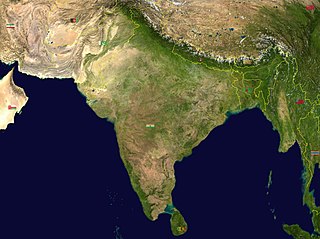
India is situated north of the equator between 8°4' north to 37°6' north latitude and 68°7' east to 97°25' east longitude. It is the seventh-largest country in the world, with a total area of 3,287,263 square kilometres (1,269,219 sq mi). India measures 3,214 km (1,997 mi) from north to south and 2,933 km (1,822 mi) from east to west. It has a land frontier of 15,200 km (9,445 mi) and a coastline of 7,516.6 km (4,671 mi).

The Himalayas, or Himalaya, is a mountain range in Asia, separating the plains of the Indian subcontinent from the Tibetan Plateau. The range has some of the Earth's highest peaks, including the highest, Mount Everest; more than 100 peaks exceeding elevations of 7,200 m (23,600 ft) above sea level lie in the Himalayas.
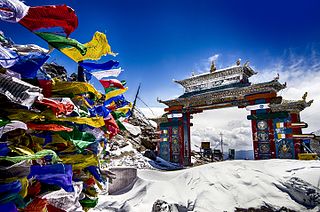
Northeast India (officially the North Eastern Region(NER)) is the easternmost region of India representing both a geographic and political administrative division of the country. It comprises eight states—Arunachal Pradesh, Assam, Manipur, Meghalaya, Mizoram, Nagaland and Tripura (commonly known as the "Seven Sisters"), and the "brother" state Sikkim.

The Kashmir Valley, also known as the Vale of Kashmir, is an intermontane valley in northern Jammu and Kashmir, a region administered by India as a union territory and part of the larger Kashmir region, which has been the subject of a dispute between India and Pakistan since 1947, and between India and China since 1962.

The Lushai (Pron: ˌlʊˈʃaɪ) Hills are a mountain range in Mizoram and Manipur, India. The range is part of the Patkai range system and its highest point is 2,157 m high Phawngpui, also known as 'Blue Mountain'.

The Kuki people are an ethnic group in the Northeastern Indian states of Manipur, Nagaland, Assam, Meghalaya, Tripura and Mizoram, as well as neighbouring countries of Bangladesh and Myanmar. The Kuki constitute one of several hill tribes within India, Bangladesh, and Myanmar. In Northeast India, they are present in all states except Arunachal Pradesh.
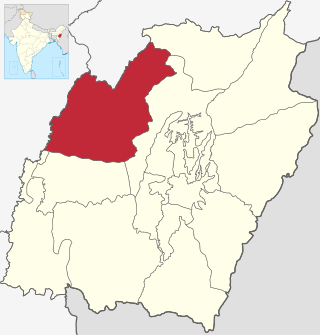
Tamenglong district is one of the 16 districts of Manipur state in northeastern India. In 2011, Tamenglong was the least populous distrct in Manipur. In 2016, the Noney subdivision was separated as a separate district.
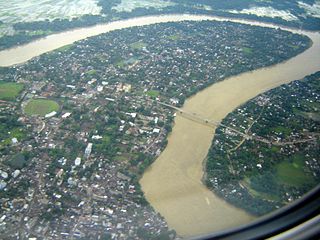
The Barak River flows 900 kilometres (560 mi) through the states of Manipur, Nagaland, Mizoram and Assam in India. Further it enters Bangladesh where it bifurcates into the Surma river and the Kushiyara river which converge again to become the Meghna river before forming the Ganges Delta with the Ganga and the Brahmaputra rivers and flowing into the Bay of Bengal. Of its length 524 km (326 mi) is in India, 31 km (19 mi) on the Indo–Bangladesh border and the rest is in Bangladesh. The upper part of its navigable part is in India — 121 km (75 mi) between Lakhipur and Bhanga, declared as National Waterway 6, (NW-6) since the year 2016. It drains a basin of 52,000 km2 (20,000 sq mi), of which 41,723 km2 (16,109 sq mi) lies in India, 1.38% (rounded) of the country. The water and banks host or are visited by a wide variety of flora and fauna.

The Geography of West Bengal, a state in eastern India, is primarily defined by plains and plateaus, with the high peaks of the Himalayas in the north and the Bay of Bengal to the south.
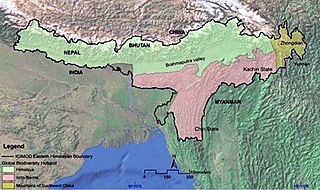
The Eastern Himalayas extend from eastern Nepal across Northeast India, Bhutan, the Tibet Autonomous Region to Yunnan in China and northern Myanmar. The climate of this region is influenced by the monsoon of South Asia from June to September. It is a biodiversity hotspot, with notable biocultural diversity.
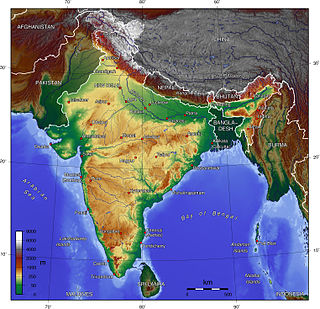
The Indian Himalayan Region is the section of the Himalayas within the Republic of India, spanning thirteen Indian states and union territories, namely Ladakh, Jammu and Kashmir, Himachal Pradesh, Uttarakhand, Sikkim, West Bengal, Manipur, Meghalaya, Mizoram, Nagaland, Tripura, Assam, and Arunachal Pradesh. The region is responsible for providing water to a large part of the Indian subcontinent and contains various flora and fauna.
Nungba is a small town surrounded by low-lying hill ranges and rivers, an extension of the eastern Indian Himalayas. The highest point of Nungba "Ramphaan But" which means "Viewpoint" stands high at the centre of the town.

The topography of Pakistan is divided into seven geographic areas: the northern highlands, the Indus River plain, the desert areas, the Pothohar Plateau, Balochistan Plateau, Salt Range, and the Sistan Basin. All the rivers of Pakistan, i.e. Sindh, Ravi River, Chenab River, Jhelum River, and Sutlej River, originate from the Himalayas mountain range. Some geographers designate Plateau as to the west of the imaginary southwest line; and the Indus Plain lies to the east of that line.

Sadar Hills is a geographic area in the state of Manipur in North East India.

Northeast India consists of the eight states Arunachal Pradesh, Assam, Manipur, Meghalaya, Mizoram, Nagaland, Sikkim and Tripura. Tourism in this area is based around the unique Himalayan landscape and culture distinct from the rest of India.

Huishu village is situated on the northeast fringe of the district headquarter, Ukhrul district, Manipur, India, and is bordered by Myanmar to the northeast, Poi village to the north, Chingai and Awang Kasom Ngahui to the northwest, Kuirei village to the west and Khamasom village to the south. Huishu is called "the green hills of the rising sun" and also "North Indo-Myanmar border corridor" of Manipur.

Koshi Province covers an area of 25,905 square kilometres (10,002 sq mi). It is located at easternmost part of Nepal bordering by Tibet Autonomous Region of China in north Bagmati Province in west, Province No. 2 in south-west, Bihar of India in south, North Bengal of India in south-east and Sikkim of India in north-east. Sikkim and part of North Bengal of India forms ethno-linguistic relation with Nepal. Geography of Koshi Province in eastern Nepal is very diverse, of highest peaks of Himalayas in northern extremes to terai region to south. It lies between 86 degree 1 minute and 88 degree 3 minutes east longitude and 28 degree 2 minutes and 26 degree 3 minutes north longitude. Biratnagar, the industrial capital of Nepal, is the temporary capital of this province.
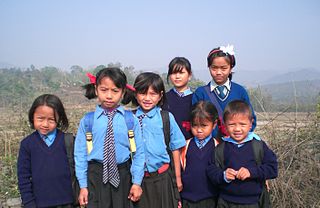
The hill tribes of Northeast India are hill people, mostly classified as Scheduled Tribes (STs), who live in the Northeast India region. This region has the largest proportion of scheduled tribes in the country.